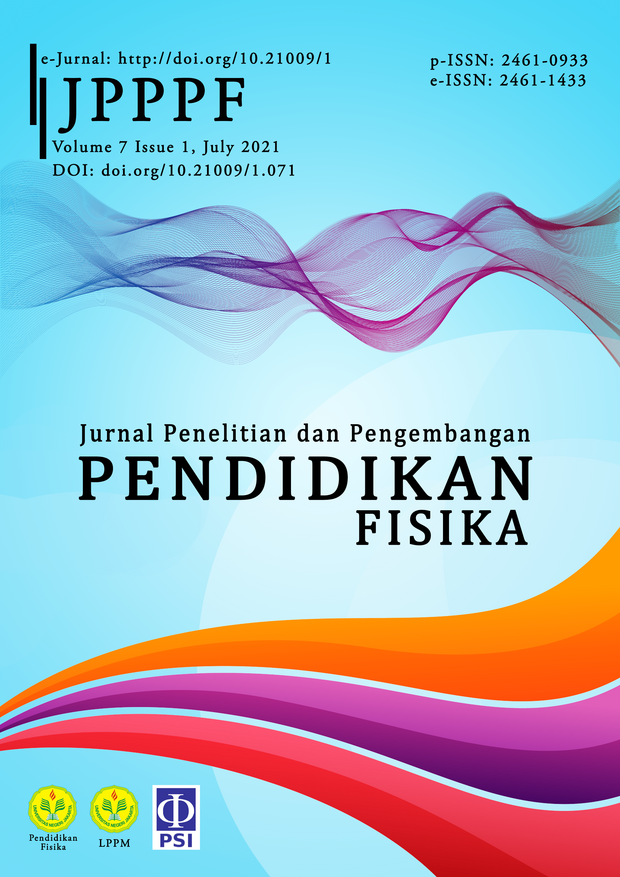The Development of Augmented Reality Application to Explore Fluid Concepts
DOI:
https://doi.org/10.21009/1.07106Keywords:
application, augmented reality, development, exploring, fluidAbstract
Exploration can be done by reading, discussing, or experimenting with collecting and processing data. In fluid material, students can explore by looking at the phenomena related to the application of Archimedes' law, Pascal's law, and Bernoulli's law. This study aims to develop teaching materials that can improve students' ability to explore fluid material. The research method used is the 4D model development research. The study results were in marker applications and augmented reality, which was validated by material experts, learning media. This application has also gone through field trials. The validation value of material experts is 86%, and media experts are 82.5%. Meanwhile, the test results for the teacher obtained 83.75%, and the students obtained 83.45%. Based on the validation results, this media is feasible to be used as a learning medium that helps students improve fluid material.
References
Abosalem, Y 2016, ‘Assessment Techniques and Students’, Higher-Order Thinking Skills, International Journal of Secondary Education, vol. 4, no. 1, pp. 1-12, doi:10.11648/j.ijsedu.20160401.11.
Agustihana, S & Suparno 2018, ‘Effectiveness of Physics Mobile Learning Media to Improve Higher Order Thinking Skills of Students in Thermodynamics’, Journal of Physics: Conference Series, vol. 1097, no. 1, p. 012031, doi:10.1088/1742-6596/1097/1/012031.
Anderson, L & Krathwohl, D 2001, ‘A Taxonomy for Learning, Teaching, and Asessing: A Revision of Bloom's Taxonomy of Education Objective’, New York: Addison Wesley Lonman Inc.
Bakri, F, Marsal, O & Muliyati, D 2019, ‘Textbooks Equipped with Augmented Reality Technology for Physics Topic in High-School’, Jurnal Penelitian and Pengembangan Pendidikan Fisika, vol. 5, no. 2, pp. 113-22.
Bakri, F, Pratiwi, S & Muliyati, D 2019, ‘Video-enriched worksheet based on augmented reality technology: The heat experiment is easier’, AIP Conference Proceedings, vol. 2169, no. 1, p. 020010.
Bakri, F, Sumardani, D & Muliyati, D 2019, ‘The 3D simulation of Lorentz Force based on augmented reality technology’, Journal of Physics: Conference Series, vol. 1402, no. 6, p. 066038.
Brookhart, M & Nitko, AJ 2011, ‘Assessment and grading in classrooms’, New Jersey: Pearson Education Inc.
Budsankom, P, Sawangboon, T, Damrongpanit, S & Chuensirimongkol, J 2015, ‘Factors affecting higher order thinking skills of students: A meta-analytic structural equation modeling study’, Educational Research and Review, vol. 10, no. 19, pp. 2639-652, doi:10.5897/ERR2015.2371
Buesing, M & Cook, M 2013, ‘Augmented Reality Comes to Physics’, The Physics Teacher, vol. 51, no. 4, pp. 226-28, doi:10.1119/1.4795365
Crăciun, D & Bunoiu, M 2017, ‘Boosting Physics Education through Mobile Augmented Reality’, AIP Conference Proceedings , vol. 1916, no. 1, p. 050003.
Cutnell, JD & Johnson, KW 2011, ‘Introduction to physics 9th Edition’, New Jersey: Wiley.
Dewi, FH, Samsudin, A & Nugraha, MG 2019, ‘An investigation of students, conceptual understanding levels on fluid dynamics using four-tier test’, Journal of Physics: Conference Series, vol. 1280, no. 5, p. 052037.
Eveline, E, Suparno, S, Ardiyati, TK & Dasilva, BE 2019, ‘Development of Interactive Physics Mobile Learning Media for Enhancing Students’, HOTS in Impulse and Momentum with Scaffolding Learning Approach, Jurnal Penelitian and Pengembangan Pendidikan Fisika, vol. 5, no. 2, pp. 123-32.
FitzGerald, E, Ferguson, R, Adams, A, Gaved, M, Mor, Y & Thomas, R 2013, ‘Augmented reality and mobile learning: the state of the art’, International Journal of Mobile and Blended Learning, vol. 5, no. 4, pp. 43-58, doi:10.4018/ijmbl.2013100103.
Hassan, SR, Rosli, R & Zakaria, E 2016, ‘The Use of I-Think Map and Questioning to Promote Higher-Order Thinking Skills in Mathematics’, Creative Education, vol. 7, no. 7, pp. 1069-1078, doi:10.4236/ce.2016.77111.
Loverude, ME, Kautz, CH & Heron, PR 2003, ‘Helping students develop an understanding of Archimedes, principle. I. Research on student understanding’, American Journal of Physics, vol. 71, no. 11, doi:10.1119/1.1607335.
Martin, J, Mitchell, J & Newell, T 2003, ‘Development of A Concept Inventory for Fluid Mechanics’, lEEE Frontiers in Education Conference, pp. 23-8.
Parno, Yuliati, L, Ndadari, IP & Ali, M 2020, ‘Project Based Learning Integrated STEM to Increase Students, Scientific Literacy of Fluid Statics Topic’, IOP Conf. Series: Journal of Physics: Conf. Series, vol. 1491, no. 1, p. 012030, doi:10.1088/1742-6596/1491/1/012030.
Permana, AH, Muliyati, D, Bakri, F, Dewi, BP & Ambarwulan, D 2019, ‘The development of an electricity book based on augmented reality technologies’, IOP Conf. Series: Journal of Physics: Conf. Series , vol. 1157, no. 3, p. 032027.
Pratama, GS & Retnawati, H 2018, ‘Urgency of Higher Order Thinking Skills (HOTS) Content Analysis in Mathematics Textbook’, IOP Conf. Series: Journal of Physics: Conf. Series, vol. 1097, p. 012147, doi:10.1088/1742-6596/1097/1/012147.
Resnick, LB 1992, ‘Educational and Learning to Think’, Washington DC: National Academy Press.
Robert, JM 1985, ‘Learning by Exploration’, IFAC Proceedings, vol. 18, no. 10, pp. 189-93, doi:10.1016/S1474-6670(17)60218-0.
Sulasih, Suparmi, A & Sarwanto 2017, ‘Profile of student critical thinking ability on static fluid concept’, IOP Conf. Series: Journal of Physics: Conf. Series, vol. 909, no. 1, p. 012060.
Thiagarajan, S, Semmel, DS & Semmel, MI 1974, ‘Instructional development for training teachers of exceptional children: A sourcebook’, Bloomington: Indiana University.
Thomas, A & Thorne, G 2009, ‘How To Increase Higher Order Thinking’, Los Angeles: Center for Development and Learning.











